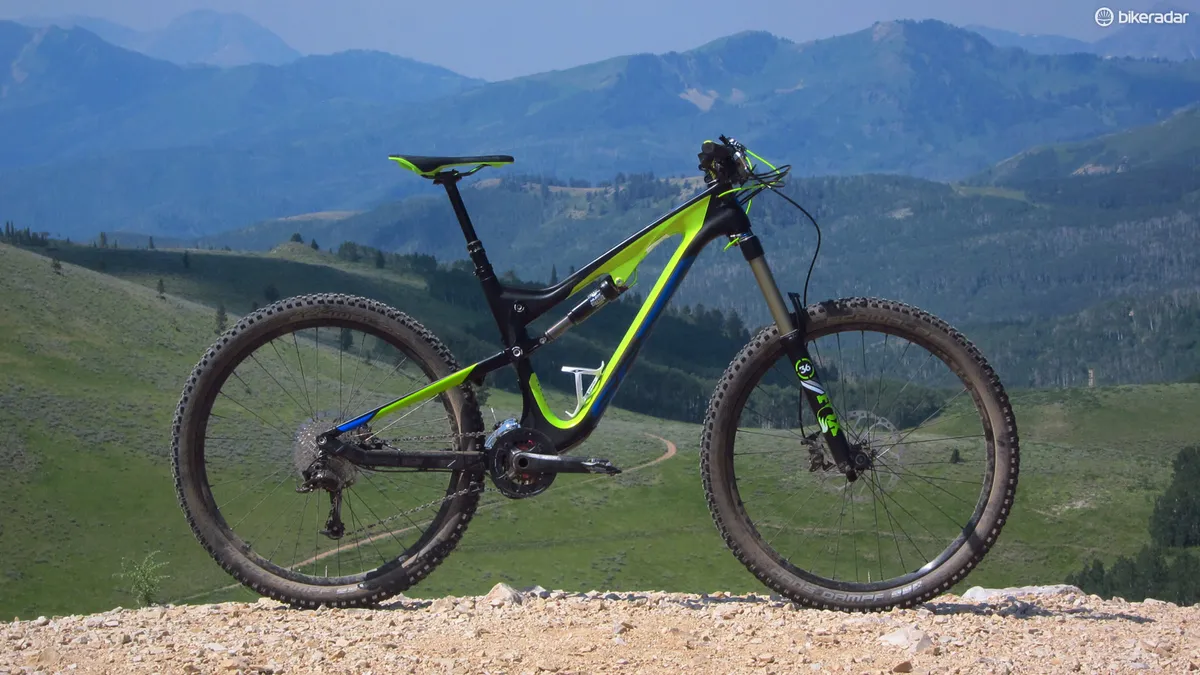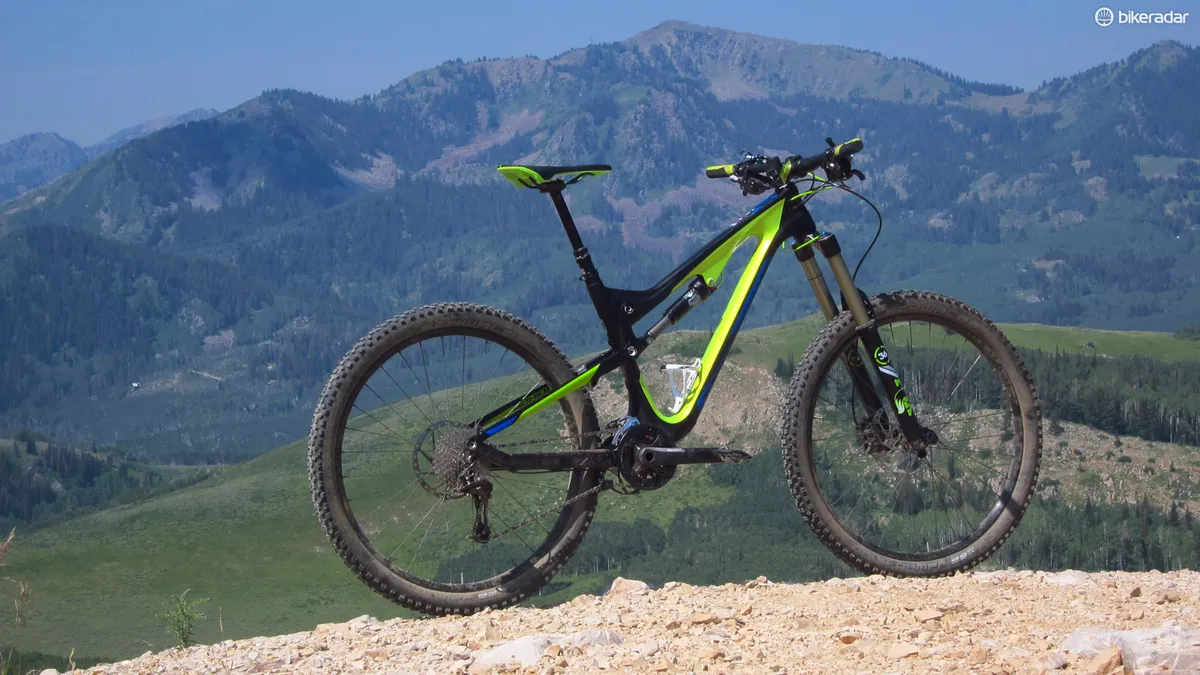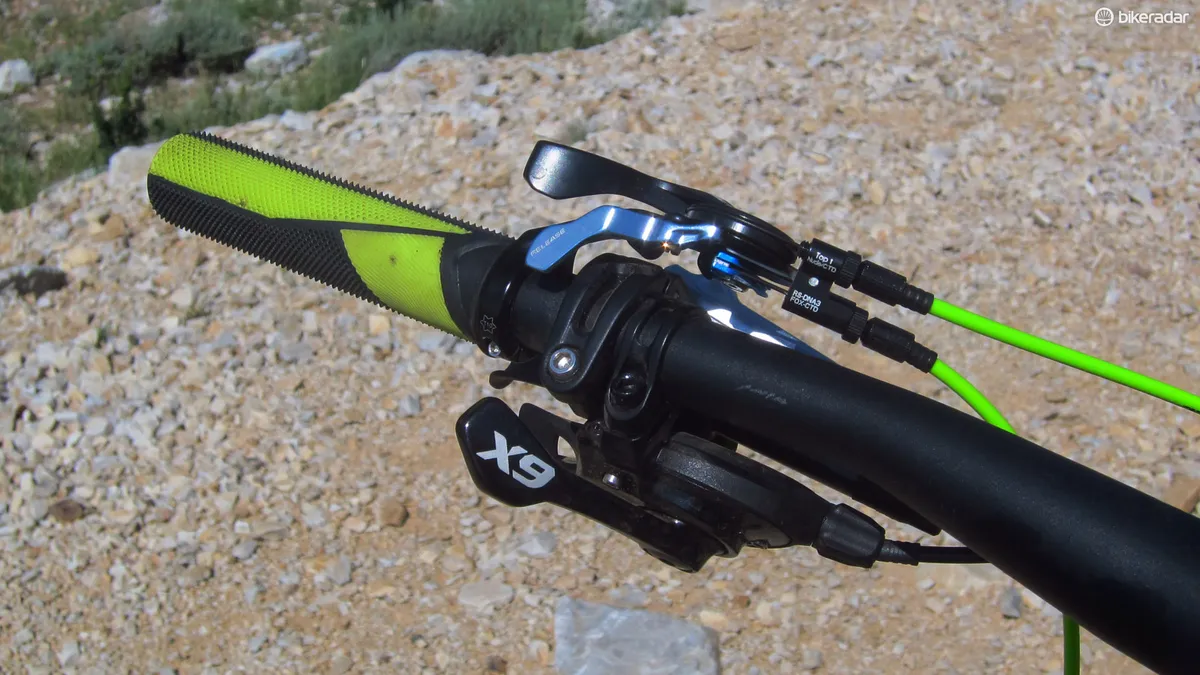Scott makes no apologies for the racing-centric tune of its latest Genius LT 710. The sleek 650b carbon beauty packs a generous 170mm of travel at either end, but don't expect a cushy feel if you're just tootling along. Only when ridden harder and faster does the beast come alive – and not everyone will like it even once awakened.
- Highs: Well controlled suspension, fantastic handling, good spec, versatile TwinLoc remote settings
- Lows: Compression damping is quite heavy, wimpy chain tensioner
- Buy if:You're a hard-hitting trail rider who isn't afraid of a firm ride and lots of levers

Heavy-handed compression damper settings feel disappointingly firm until you ride the bike harder and faster
Ride and handling: Firm and controlled with great handling
Suspension settings for top pros rarely jive with those of everyday riders and, interestingly, Scott seems to have made a conscious risk of alienating bread-and-butter buyers. Even in the adjustable system's most active setting, both the front and rear ends sport rather firm compression damping that many riders might find bouncy, skittery, or just plain uncomfortable.
Although the Genius LT certainly isn't the smoothest or plushest ride at slower-to-medium speeds, that firm suspension tune yields very good control at higher speeds and when pushed harder, which can especially benefit more aggressive riders who rely more on their bodies than their bikes to suck up the small stuff. Keep in mind, too, that we're not talking about air pressure here. Both Scott and Fox confirmed that the bike comes with higher compression damping rates than average and we actually ran slightly lower pressures than recommended to temper that inherent tune a bit.

The custom Fox shock feels notably better than previous editions but the overall feel might still not be to everyone's liking
Even so, we still found it hard to get full travel – the bike feels like it has less than it actually does – although to be fair, the trails at Deer Valley, Utah are only moderately demanding in terms of drops and impacts. We'd have to get a long-term sample on more arduous terrain to be sure, but there's at least the suggestion that there's a little more movement available when you really need it.
Although the firm tune negatively affects ride quality, the upside is pretty decent pedal-pushing performance despite the relatively low pivot location of the modified single-pivot rear suspension layout. That said, there's only so much the damping can do and, unless you make liberal use of Scott's TwinLoc remote, it's still fairly easy to overcome the platform with a hard stab at the pedals.
Speaking of which, the novel TwinLoc remote shock and fork adjuster really does work well. The middle 'traction' setting steepens the air spring curve and firms up the compression damping even further for what is honestly better pedaling performance than any 170mm-travel machine deserves to have, plus the steeper curve sits the rear end a little higher in its stroke to help you maintain weight up front on climbs. The full lockout setting is indeed extremely firm to the point where it's really only useful on paved or dirt road climbs – undoubtedly to the delight of the European buyers that are so important to Scott's business.

It's critical to toggle the TwinLoc lever fairly regularly in order to get the most out of the bike
That all said, we nevertheless find the TwinLoc concept to be a divisive one. On the one hand, it does what it says and offers an impressive level of manual control, effectively melding the capabilities of two bikes into one. However, it still feels like all the damping and remote gadgetry is there to make up for what is ultimately a fairly so-so suspension design. Plus, given that riders have Traction mode at their fingertips, we'd rather the 'open' setting actually feel a little more open.
We suspect that very few people will have any complaints about the bike's handling, though. The Genius LT 710 frame offers its riders two geometry settings and we opted for the lower and slacker position for our two-day test session. In that guise, the head tube angle is a laid-back 66.3 degrees but the bottom bracket is still a reasonable 346mm off the ground – unsagged, of course.

The newly revamped Fox 36 is fantastic and pairs well with the frame
Combined with the fairly short rear end, the Genius LT 710 is at once brilliantly stable and fun on fast downhills and yet impressively nimble in tighter sections of trail. It takes little effort to loft the front end when needed, too, and the stubby stem-friendly cockpit felt spot-on for general trail riding. Though we clipped a pedal a handful of times during our two test days, it was a small price to pay for the bike's brilliant drift characteristics.
Frame: Gorgeous lines, thoughtful details
The Genius LT 710 frame is stunning to look at with a compact and low-slung profile all covered in a smart matte black, neon green, and blue paint job. The forged aluminum shock link is so neatly integrated into the rest of the frame shape that it practically disappears, and the internal cable routing not only keeps the exterior free of clutter but features clamped entry and exit ports that cut down on housing rattle.

The internal cable routing is neatly done and quiet
Details are well thought-out with molded-in ISCG tabs surrounding the 92mm-wide press-fit bottom bracket shell, a burly carbon guard on the underside of the down tube, stock angle-adjustable headset cups, and rear dropouts that can be converted from the stock 142x12mm hub spacing (although we're not sure why anyone would). The suspension pivots use collet-style hardware and large-diameter bearings for longer service intervals and less creaking, plus it's all shared with Scott's Spark and standard Genius platforms for easier sourcing.
While the top-end Genius LT 910 frame uses Scott's premium HMX carbon blend, the 710 uses a lesser HMF recipe that presumably adds a bit of weight and perhaps decreases frame stiffness some. We didn't ride one to compare, though, and this one felt plenty stout for our needs. Either way, both the chainstays and seatstays are made of TIG-welded aluminum.

The carbon front triangle is paired to an aluminum rear end
Equipment: Mostly fantastic kit
Scott dresses the Genius LT 710 frame in an excellent ensemble of gear that's well suited for the intended usage, putting function first and weight second. Even so, actual weight for a medium-sized sample is quite light at 13.95kg (30.75lb) without pedals – 350g heavier than claimed.
This year's edition switches from the Fox 34 used previously to the company's all-new 36 – and it's a most welcome change. The bigger stanchions are notably stiff and when combined with the stout frame and new 35mm-diameter stubby stem and 760mm-wide bar, there's heaps of leverage for charging through rough terrain. Fox's latest damper settings also yield a nicely controlled feel up front although, as we noted earlier, in this case it's still at its best when ridden hard and fast.
Matching that mentality are the stock 2.35in-wide Schwalbe Hans Dampfs with their impeccably grippy knobs, which beg you to lean just that little bit further. Cornering traction was very good even on Deer Valley's relatively loose-over-hardpack terrain and drift characteristics were predictable and consistent. Despite plenty of sharp rocks littered throughout the trail, the sidewalls bore negligible scars even after two days of mostly lift-serviced riding.

Grippy Schwalbe Hans Dampf tires feature front and rear
That said, the grip on the rear was almost a bit too good. We wished for the faster-rolling and easier-sliding nature of the Genius LT 910's Rock Razor instead, if only to help snap the back end around on tight downhill switchbacks.
Once again, Scott has equipped its second-tier Genius LT model with a 2x10 SRAM X7/X9 transmission – a decision some might rightfully question given the added security and newly accessible cost of SRAM's dedicated 1x drivetrains. Much as we love single-ring setups here at BikeRadar, this still seems like a good choice overall. The wider gear range suits the frame's versatile nature well – it is meant to go up and down, after all – and thanks to the clutch-equipped rear derailleur, chain security was actually pretty good and shift quality was excellent at both ends.

Some might find it odd to see a 2x drivetrain here, but other editors on 1x-equipped machines quickly ran out of gear
Scott tries to further temper any criticism by fitting a chainstay-mounted tensioner just behind the crankset. Unfortunately, though, it's woefully underequipped for the job with cheap plastic clamshell construction that failed literally within the first couple of minutes after pointing ourselves downhill. A simple zip-tie would likely help hold things together but then again, such jerry-rigged solutions have no place on a bike costing as much as this one.
We had no issues with the other bits, however – at least not during our short test period. Shimano's hydraulic disc brakes continue to impress with the mid-level SLX ones specced here providing outstanding power and lever feel along with excellent control and quiet operation. Their long-term reliability is well proven at this point, too.

The stock Shimano SLX brakes are fantastic in terms of power, control, and reliability
Kudos to Scott for including RockShox's Reverb Stealth dropper seatpost, too. Although the additional remote makes for a rather busy cockpit, there's simply no place for a fixed seatpost on a bike of this nature.
The final word
Overall, we liked the Genius LT 710 for its truly versatile, go-anywhere character that's well suited for both fast, technical downhills and the long climbs required to get you there. The handling is brilliant and save for a few niggles, the spec is generally spot-on, too. Prospective buyers are bound to find the rather firm suspension to be a love/hate affair, though.

Complete bike specifications
- Frame: Scott Genius LT 710, HMF carbon, 170mm travel
- Rear shock: Fox Nude CTCD
- Fork: Fox 36 Float 27.5 170 FIT CTD, 170mm travel
- Headset: Syncros/VP-J205AM1, 1 1/8-to-1 1/2in tapered, adjustable angle
- Stem: Syncros XR1.5, 90mm x -6°
- Handlebar: Syncros AM1.5 10Rise, 760mm
- Grips: Syncros lock-on
- Front brake: Shimano SLX BR-M675 w/ 203mm SM-RT64 Center Lock rotor
- Rear brake: Shimano SLX BR-M675 w/ 180mm SM-RT64 Center Lock rotor
- Brake levers: Shimano SLX BR-M675
- Front derailleur: SRAM X7, S3 direct-mount
- Rear derailleur: SRAM X9 Type 2
- Shift levers: SRAM X9 trigger
- Cassette: Shimano CS-HG50-10, 11-36T
- Chain: KMC X10
- Crankset: SRAM S-1400 2.2 AM GXP, 22/36T
- Bottom bracket: SRAM GXP PF92
- Pedals: n/a
- Rims: Syncros AM-67 Disc, 32h
- Front hub: Shimano SLX HB-M678, 15x100mm thru-axle, 32h
- Rear hub: Shimano SLX FH-M678, 142x12mm thru-axle, 32h
- Front tire: Schwalbe Hans Dampf EVO TrailStar, 27.5 x 2.35in
- Rear tire: Schwalbe Hans Dampf EVO PaceStar, 27.5 x 2.35in
- Saddle: Syncros XM2.0
- Seatpost: RockShox Reverb Stealth

















